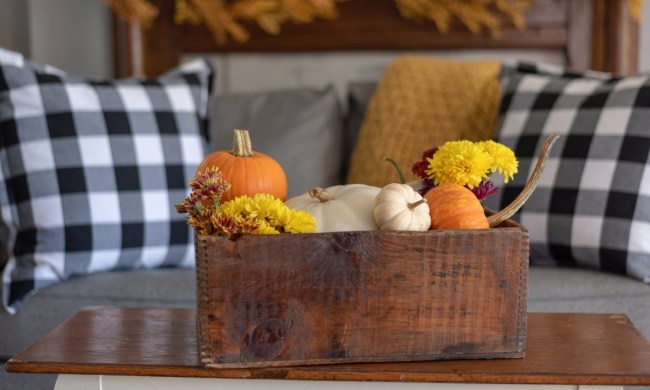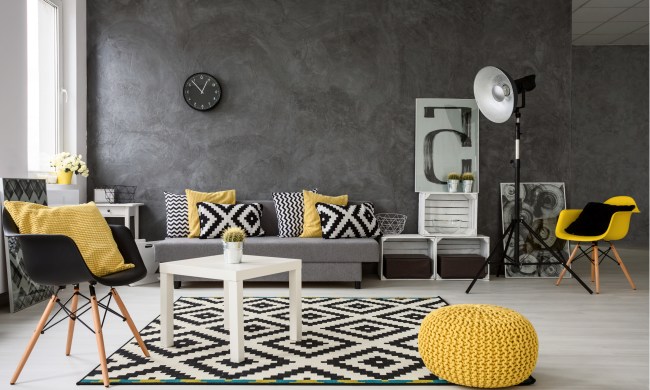Vintage and antique furniture can beautifully accent any home, adding a little character and history that makes it feel cozy and elegant. However, these pieces are often expensive and well outside the budget of a modest home remodel. Thankfully, you can transform newer pieces of furniture and decor to give them an aged look without having the pay the price of an authentic piece.
Mirrors are gorgeous statement pieces that can make a room appear bigger, and ornate mirrors add an element of classic luxury. However, true vintage mirrors are expensive and heavy, so, instead, we recommend spending a few hours making your own. Want to learn more? Below, we’ll walk you through the relatively simple process step-by-step.

These are the supplies you’ll need
- Mirror
- Bleach and water
- Paint stripper
- Spray bottle
- Paint scraper
- Safety glasses
- Protective gloves
- Paper towels
- Antique gold spray paint
Before you begin distressing your mirror, prepare the work area first. For your health and safety, ensure there’s plenty of ventilation because you’ll be working with chemicals that have harmful properties. Along these same lines, be sure to wear personal protective equipment (PPE) like safety glasses and plastic gloves, since some chemicals can burn or irritate the skin.
Take the back off the mirror
Start by removing the back of the mirror. If it’s framed, you can easily slide the cardboard out the back and set it aside. You’ll replace this piece once the antiquing process is finished.
Be careful here because the cardboard backing may be held on by staples. You don’t want to rush through the job and rip up the cardboard, leaving you with a mangled backing. To remove the staples, use a flat head screwdriver or pliers to pry them up before sliding the cardboard out. Remember, you can always staple the backing back on if you need to.
Remove the film from the back of the mirror with a paint stripper
Most mirrors have some paint coating on them, so you need to remove this paint layer from the back of your mirror using a paint stripper. This chemical is very strong, so wear PPE as you apply it to the back of the mirror using a paintbrush. The goal is to remove the paint while revealing the reflective film that causes the glass to actually be reflective.
Go slow, and feel free to be uneven with the application, using more of the paint stripper in some parts than others. In the end, it’ll give your mirror a rougher, more rustic feel. Once you’ve brushed on the paint thinner, simply wait about five to eight minutes for the chemicals to do their magic. Next, take the paint scraper and gently start scraping off the layer of paint.
Once you’ve finished scraping, take some damp paper towels and wipe down the back of the mirror. This step ensures that you don’t accidentally leave excess paint stripper on your mirror, which could continue to eat through the film. Remember that less is more here — the mirror should look distressed but not unusable.
Spray the back of the mirror with a bleach-water solution
To really drive home the rustic look, grab the spray bottle, fill it with bleach, and spray the back of the mirror. Mix the water and bleach solution outside to prevent yourself from inhaling the chemicals. If this isn’t possible, wear a mask to protect yourself.
To make the mirror look more authentically aged, use a cloth to rub it a bit or blot it so the distressing doesn’t look so planned. Be careful not to leave the bleach on for too long or it will eat through the film that makes up the mirror.
This process takes some practice, so we recommend trying it out first on an inexpensive mirror you don’t mind throwing away if it doesn’t go as planned. Once you’re comfortable enough to work with your mirror of choice, take a “less is more” approach here as well. Continue spraying and wiping gradually to prevent yourself from overdoing it.

Paint the back of the mirror
Once you’ve achieved the look you want, use the antique gold spray paint to paint the back of the mirror. This both protects the reflective coating and will show through on the front side of the mirror. Once this has dried, you can reassemble the mirror.
Wrapping up
Mirrors really open up a space and make the room feel larger than it is, so they’re a great asset in homes of any design style and size. Antique mirrors, both authentic or otherwise, can add a sense of history to the house, regardless of when it was built, so you can have a statement piece that will amaze your guests. To get the precise look you want, just remember to have fun, take your time, and be prepared to practice on more than one mirror.



